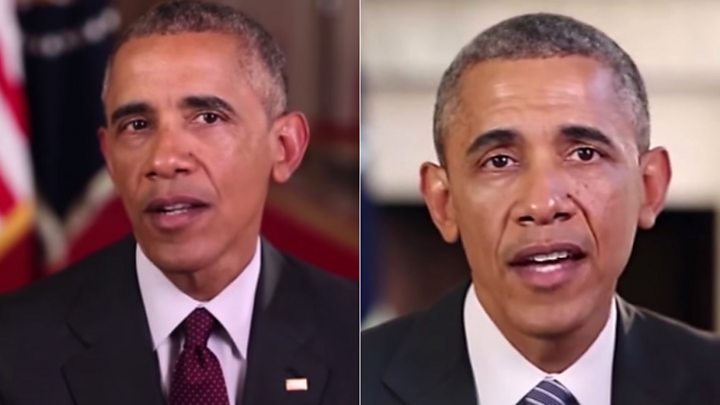TED 2018: Fake Obama Video Creator Defends Invention

 Image copyright
Bret Hartman/TED
Image copyright
Bret Hartman/TED
A researcher who created a fake video of President Obama has defended his invention at the latest TED talks.
The clip shows a computer-generated version of the former US leader mapped to fit an audio recording. Experts have warned the tech involved could spark a "political crisis".
Dr Supasorn Suwajanakorn acknowledged that there was a "potential for misuse".
But, at the Vancouver event, he added the tech could be a force for good.
The computer engineer is now employed by Google's Brain division. He is also working on a tool to detect fake videos and photos on behalf of the AI Foundation.
Damage risk
Dr Suwajanakorn, along with colleagues Steven Seitz and Ira Kemelmacher-Shlizerman from the University of Washington, released a paper in July 2017 describing how they created the fake Obama.

Media playback is unsupported on your device
They developed an algorithm that took audio and transposed it on to a 3D model of the president's face.
The task was completed by a neural network, using 14 hours of Obama speeches and layering that data on top of a basic mouth shape.
Dr Suwajanakorn acknowledged that "fake videos can do a lot of damage" and needed an ethical framework.
"The reaction to our work was quite mixed. People, such as graphic designers, thought it was a great tool. But it was also very scary for other people," he told the BBC.
Political crisis
It could offer history students the chance to meet and interview Holocaust victims, he said. Another example would be to let people create avatars of dead relatives.
Experts remain concerned that the technology could create new types of propaganda and false reports.
"Fake news tends to spread faster than real news as it is both novel and confirms existing biases," said Dr Bernie Hogan, a senior research fellow at the Oxford Internet Institute.
"Seeing someone make fake news with real voices and faces, as seen in the recent issue about deepfakes, will likely lead to a political crisis with associated calls to regulate the technology."
Deepfakes refers to the recent controversy over an easy-to-use software tool that scans photographs and then uses them to substitute one person's features with another. It has been used to create hundreds of pornographic video clips featuring celebrities' faces.
Dr Suwajanakorn said that while fake videos were a new phenomenon, it was relatively easy to detect forgeries.
"Fake videos are easier to verify that fake photos because it is hard to make all the frames in video perfect," he told the BBC.
"Teeth and tongues are hard to model and could take another decade," he added.
The researcher also questioned whether it made sense for fake news creators to make complex videos "when they can just write fake stories".
From Chip War To Cloud War: The Next Frontier In Global Tech Competition
The global chip war, characterized by intense competition among nations and corporations for supremacy in semiconductor ... Read more
The High Stakes Of Tech Regulation: Security Risks And Market Dynamics
The influence of tech giants in the global economy continues to grow, raising crucial questions about how to balance sec... Read more
The Tyranny Of Instagram Interiors: Why It's Time To Break Free From Algorithm-Driven Aesthetics
Instagram has become a dominant force in shaping interior design trends, offering a seemingly endless stream of inspirat... Read more
The Data Crunch In AI: Strategies For Sustainability
Exploring solutions to the imminent exhaustion of internet data for AI training.As the artificial intelligence (AI) indu... Read more
Google Abandons Four-Year Effort To Remove Cookies From Chrome Browser
After four years of dedicated effort, Google has decided to abandon its plan to remove third-party cookies from its Chro... Read more
LinkedIn Embraces AI And Gamification To Drive User Engagement And Revenue
In an effort to tackle slowing revenue growth and enhance user engagement, LinkedIn is turning to artificial intelligenc... Read more

